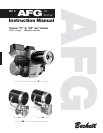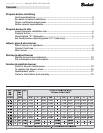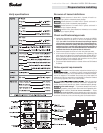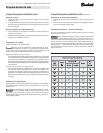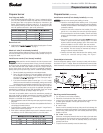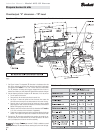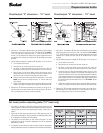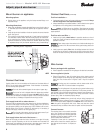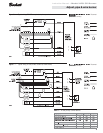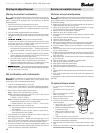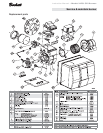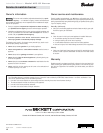
Instruction Manual – Model AFG Oil Burner
5
Figure 1 — Electrode settings
Install burner nozzle (if not already installed) (continued)
Use care when removing and installing oil nozzles:
• Inspect the nozzle adapter before installing nozzle. If it is grooved
or scratched on the sealing surface, replace the nozzle line assembly.
Otherwise, oil could leak at the nozzle-adapter joint, causing serious
combustion problems.
• Protect the nozzle orifice and strainer when installing. If the orifice
gets dirt in it or is scratched, the nozzle will not function properly.
• Do not over-torque the nozzle when installing. This will cause deep
grooves in the nozzle adapter, preventing a seal when a new nozzle
is installed.
• Use a wrench or vise to hold the nozzle adapter. attempt to
remove or replace nozzle without holding adapter. The nozzle
alignment could be seriously damaged. Use a nozzle wrench that
secures the adapter or use 3/4" and 5/8" open-end wrenches.
• Do not squeeze the electrodes too tightly when handling the nozzle
line assembly. This could change the electrode tip settings or
damage the ceramic electrode insulators.
• Carefully check and realign electrode tips after replacing nozzle,
ensuring the electrode settings comply with Figure 1.
Check/adjust electrodes
Check the electrode tip settings. Adjust if necessary to comply with the dimen-
sions shown in Figure 1. To adjust, loosen the electrode clamp screw and slide/
rotate electrodes as necessary. Securely tighten the clamp screw when finished.
Servicing nozzle line assembly
1. Turn off power to burner before proceeding.
2. Disconnect oil connector tube from nozzle line.
3. Loosen the two screws securing igniter retaining clips and rotate both clips
to release igniter baseplate. Then tilt igniter back on its hinge.
4. Remove splined nut.
5. “ ” head air tubes
Remove nozzle line assembly from burner, being careful not to damage the
electrodes or insulators while handling. To ease removal of long assemblies
(over 9 inches), rotate assembly 180° from installed position after pulling
partially out of tube.
6. “ ” and “ ” head air tubes
Slide nozzle line assembly forward (further into air tube) so the head clears
the venturi opening. Then rotate the nozzle line assembly 90° so the nozzle
line end points up. Pull the nozzle line assembly toward you and remove
assembly from burner.
7. To replace the nozzle assembly, reverse the above steps.
Low firing rate baffle
• The AFG Low Firing Rate Baffle (LFRB), item 7, page 11, reduces the air flow
(cfm). The LFRB is sometimes used for firing rates under 1.00 GPH as listed in
the table below. Refer to the appliance manufacturer’s instructions or the
Beckett
OEM Specification Guide
part number 6711. Do not omit the LFRB
when specified. Omitting the baffle when specified or installing the baffle
when not specified could result in poor burner performance.
Burner fuel unit
• Verify that the burner fuel unit is compatible with the oil supply system. For more
details, refer to “ ” on page 8.
Attach air tube (if not already installed)
If using a flange and gasket, slide them onto the air tube. Then attach the air tube
to the burner chassis using the four sheet metal screws provided. See Figure 2
on page 6 for details.
Install burner nozzle (if not already installed)
Make certain the nozzle is selected for the fuel unit pressure used.
For applications with fuel unit pressure above 100 psig, the nozzle rated capac-
ity will be less than the appliance firing rate. Use only the specified spray pat-
tern unless combustion test results indicate the need for a change. Failure to
use the correct nozzle size and type can result in unacceptable combustion,
possibly causing severe personal injury, death or substantial property damage.
1. Remove the plastic plug protecting the nozzle adapter threads.
2. Place a ³⁄₄" open-end wrench on the nozzle adapter. Insert the nozzle
into the adapter and finger tighten. Finish tightening with a ⁵⁄₈" open-
end wrench. Use care to avoid bending the burner head support legs or
electrodes. See , above right.
3. If you remove the head to replace the nozzle (type “L1” or “V1” heads),
carefully reconnect the head to the nozzle adapter, making sure to butt the
head support to the nozzle adapter shoulder (see Figures 3 and 4, page 7).
If the nozzle is already installed, remove the nozzle line assembly to verify that
the nozzle size and spray pattern are correct for the application (per appliance
manufacturer’s information or Beckett
OEM Specification Guide,
part number
6711. Verify that the electrode tip settings comply with Figure 1.
If the nozzle is not installed, obtain a nozzle of the manufacturer, capacity and
spray angle specified in appliance manufacturer’s information or Beckett
OEM
Specification Guide
, part number 6711. For conversions or upgrades, when in-
formation is not available for the application:
1. Refer to table below to select the mid-range nozzle spray angle for the head type
being used.
2. Fire the burner and make sure the combustion is acceptable and the flame is
not impinging on chamber surfaces.
3. If a shorter flame is needed, select a wider spray angle. If a longer flame is
needed, select a narrower spray angle.
4. Either hollow or solid spray patterns may be used. If combustion results are
not satisfactory with the selected spray pattern, try the other pattern.
Prepare burner & site
Prepare burner Prepare burner (continued)



